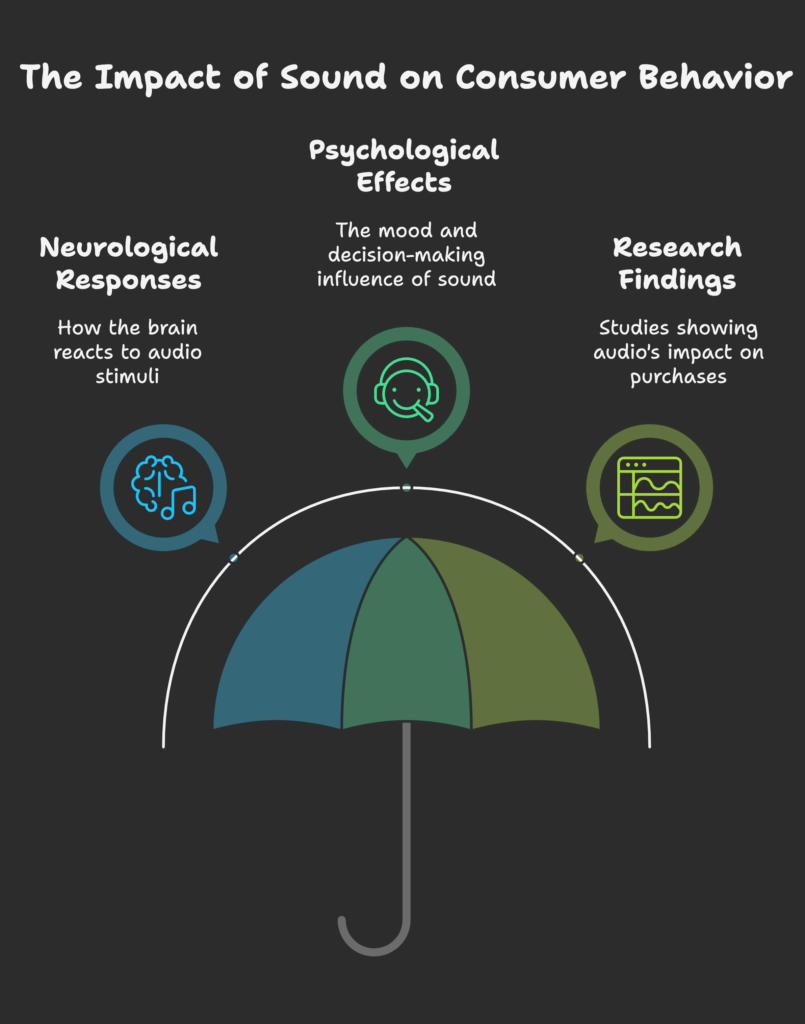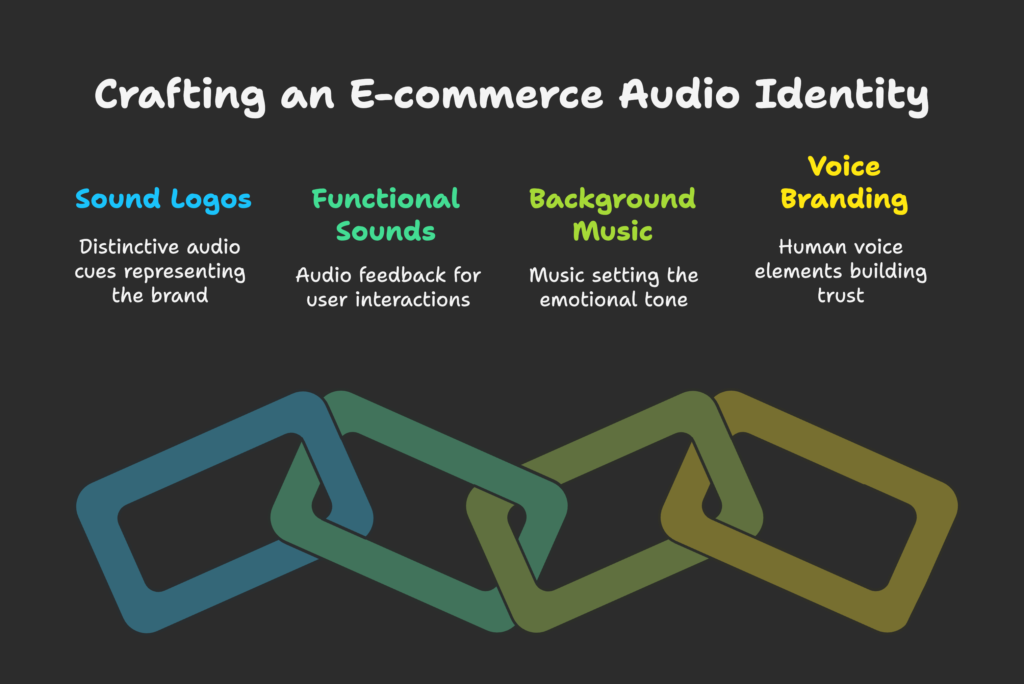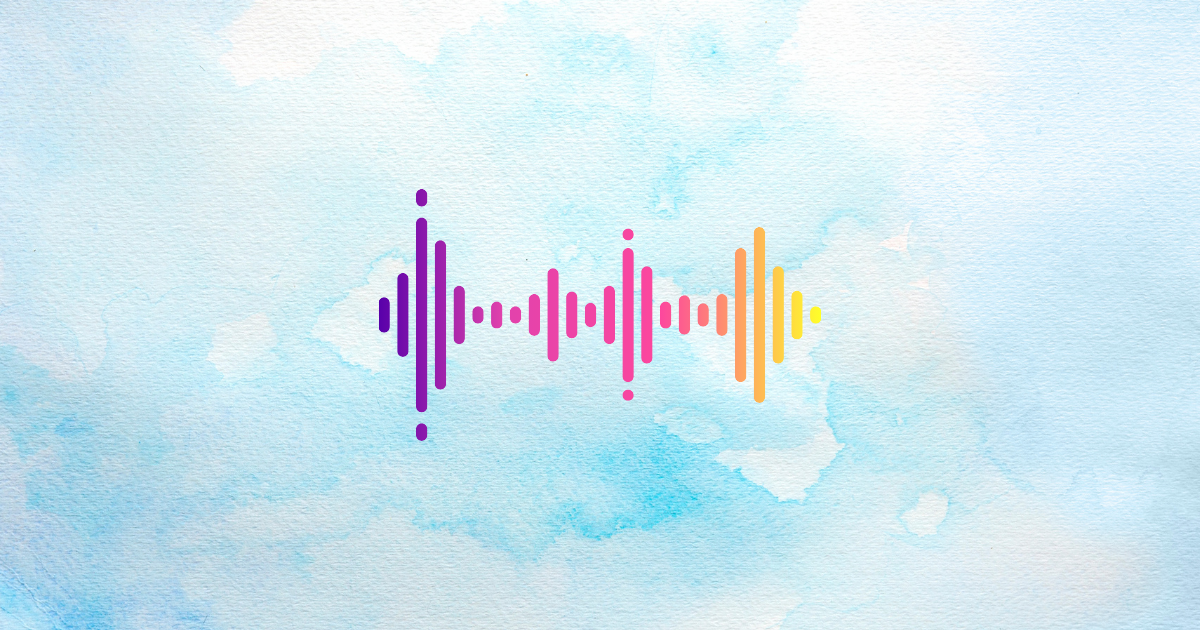Have you ever caught yourself humming a catchy tune from a commercial or replaying a brand’s distinct jingle in your head? Sounds can sneak into our minds and linger there far longer than visuals alone. If you’ve ever wondered why certain sounds influence you to trust, remember, or even make a purchase, you’re in the right place! By the time you finish reading this article, you’ll have a clear understanding of how audio branding can bridge the sensory gap in online shopping and boost customer engagement. Ready to explore the world of sonic branding? Let’s get started!
Definition and Scope
Audio branding—often called sonic branding—is the strategic use of sound elements to express a brand’s identity. Traditionally, this might have meant a simple jingle on the radio or TV, but in our digital era, it expands to notifications on mobile apps, sound logos on websites, and even subtle background music when browsing online stores. As more shoppers move to e-commerce platforms, audio branding fills a sensory gap that visual ads alone cannot address.
Research shows that online shoppers respond favorably to sonic cues, with higher recall rates and stronger emotional connections. In fact, some studies highlight that sound can influence consumer decision-making by a substantial margin—enough to elevate purchase intent and drive meaningful brand engagement.
What’s next? You’ll soon discover why investing in audio branding offers significant benefits for e-commerce businesses. Let’s find out the bigger business case behind these harmonious strategies.
The Business Case for Audio Branding
While many e-commerce stores are familiar with visuals, only a fraction have explored the power of audio branding. Yet data consistently shows that sound can significantly boost purchase intent. When your brand stands out with a memorable sound signature or even simple yet effective navigation cues, you gain a serious competitive edge. Shoppers don’t just see your brand; they hear and feel it.
On top of that, the return on investment (ROI) in audio branding can be impressive. Once the initial development cost of a sound logo or background score is covered, it can be repeatedly used across platforms—from your website to your mobile app and even in advertising campaigns—amplifying brand recognition at every step.
Excited to dig deeper? Let’s see how psychology underpins these positive effects of audio branding and makes them so powerful.
Psychological Foundation
Humans have an innate emotional response to sound. A simple melody or familiar voice can transport us to a different time or place, activating deep memories more effectively than visuals. Neurological studies show that when we hear certain sounds, our brains release dopamine, the “feel-good” chemical, making us more receptive to positive brand messages.
Because sound can create potent emotional triggers, brands that use audio wisely often see improved recall and stronger loyalty. By the end of this article, you’ll have all the insights you need to tap into this psychological phenomenon and build a robust audio strategy.
Ready for the next step? Let’s dive into the deeper science behind how our brains process sound and how this influences our shopping choices.
The Science of Sound and Consumer Behavior
In this section, you’ll learn how the brain processes audio stimuli, why certain sounds make us feel happy or relaxed, and how these reactions tie directly to our purchasing decisions. By understanding the science, you can more deliberately shape your customers’ journey.

Neurological Responses to Audio Stimuli
Our brains are wired to pay attention to audio cues. When you hear a pleasant jingle, specific areas of your brain tied to memory and emotion light up. The sound signals travel quickly, reaching the amygdala (the emotional center of the brain), causing you to feel something before you’ve even processed what you heard logically. This immediate emotional response can be a powerful catalyst for brand affinity and loyalty.
The release of dopamine associated with pleasing sounds further heightens this impact. So, if your e-commerce store uses a welcoming tune upon website entry, you’re already setting a positive emotional foundation for the shopping experience.
Curious to see how this boosts decision-making? Let’s move on to how sound can actually drive purchase choices.
The Psychology of Audio-Enhanced Decision Making
From gentle background tunes that put customers at ease to a lively jingle that sparks excitement, audio can guide mood and influence shopping decisions. Music, for instance, is a powerful mood inducer—slow tempos can encourage leisurely browsing, while upbeat tunes can energize shoppers to buy on impulse.
Voices also play a critical role. A friendly, trustworthy voice in product demonstrations or chat support can foster a sense of human connection, easing concerns and solidifying trust. When you combine these auditory elements with visuals, the shopper’s brain processes the experience as more immersive, leading to enhanced engagement and, often, higher sales.
Want the proof? Next, let’s look at research findings that show how these elements directly affect purchase intent.
Research Findings on Audio and Purchase Intent
Multiple studies have shown that about 77% of digital audio listeners are more inclined to purchase after hearing audio ads. Another set of data points to improved conversion rates when brands use distinct sound signatures across their marketing channels. What’s more, personalized audio—like tailored voice messages or custom playlists—can have a lasting effect on brand loyalty.
Short-term boosts in sales are often noticeable right away, but the true magic of audio branding lies in its long-term impact. Customers not only recognize and remember your brand, they also develop an emotional bond that keeps them coming back for more.
Ready for the next step? Let’s now explore the specific elements of audio branding for your e-commerce platform.
Audio Branding Elements for E-commerce
Here, we will break down the main components of audio branding, from sound logos and functional sounds to ambient music and voice narration. By the end of this section, you’ll know exactly what ingredients can spice up your online store’s audio identity.

Sound Logos and Brand Signatures
A sound logo is a brief, distinctive series of notes or tones that immediately evokes a brand’s identity. Think of Netflix’s “ta-dum” sound—short, sweet, and memorable. These signatures can be woven into various points of a customer’s journey, such as when they land on your homepage or complete a purchase.
Developing a compelling sound logo involves understanding your brand’s personality and customer expectations. The best audio signatures feel authentic to the brand, are easy to recognize, and stay consistent across channels.
Eager for more? Let’s look at practical ways to incorporate functional sounds in your user interface next.
Functional Sounds and Interface Audio
Functional sounds—like clicks for navigation or confirmation tones after a completed action—reinforce the idea that the system acknowledges user input. These sounds should be subtle but reassuring, letting shoppers feel confident about what they’re doing. A pleasant “ding” when an item is added to the cart can signal success and build excitement.
It’s crucial, however, to balance these cues with brand consistency. An alarming sound for a notification might grab attention, but it could create unnecessary stress. Choose tones that reflect your brand’s vibe while giving users helpful feedback.
Ready for more audio inspiration? Up next: background music and ambience.
Background Music and Ambient Sound
Background music is a classic way to shape emotions. If your store sells high-end furniture, a calm, sophisticated track can make visitors feel relaxed and assured of your product’s quality. For a tech gadget shop, a modern electronic beat could spark a sense of innovation.
- Tempo: A slow tempo encourages a more thorough browse.
- Genre: Choose genres that match your brand’s essence—classical, pop, or ambient.
- Culture: Keep in mind that musical preferences vary across regions. Stay inclusive.
Some brands even use soft ambient noises—like the gentle hum of a café—to emulate real-world shopping vibes. This subtle layer of sound can make digital environments feel more welcoming.
Up next? We’ll talk about the power of voice in creating an emotional bridge with customers.
Voice and Verbal Branding
A human voice can add warmth to your digital presence. Whether it’s a voice-over in product videos or a welcome message in your app, choosing the right tone, accent, and style is key to building trust. Scriptwriting also matters: use clear, concise language that matches your brand’s personality.
With the rise of voice commerce and smart assistants, having a consistent verbal identity strengthens customer relationships. Think about how your brand voice might integrate with devices like Amazon Echo or Google Home—consistency in voice branding can significantly enhance user recognition.
Need to see how all these elements come together? Let’s move on to implementation across different e-commerce touchpoints.
Implementation Across E-commerce Touchpoints
In this part, you’ll see exactly where and how to apply audio branding elements in your online store—covering everything from your main website to your social media ads. By the end, you’ll have a roadmap for a truly unified audio experience.
Website and Mobile App Integration
The first step is choosing suitable file formats for quick loading without compromising sound quality. You’ll also want to offer user controls (like a volume slider or mute option) to keep the experience comfortable for everyone. It’s wise to keep your audio responsive across devices so the sound plays smoothly on desktops and mobile.
Running A/B tests to compare user responses with or without audio can give you measurable insights. Track metrics like time spent on site, click-through rates, and overall customer satisfaction to gauge success.
Curious how audio works in the shopping cart? Let’s check that out next.
Product Pages and Shopping Cart Experience
Some brands include short audio clips that highlight product features. For example, if you sell coffee machines, a snippet of that comforting brewing sound can make the product feel tangible. Such audio enhances product understanding and can boost confidence in the buying decision.
Audio cues can also help reduce cart abandonment. A gentle reminder sound or a friendly voice message when items are left in the cart can nudge shoppers back. Checkout process sounds—like a soft chime upon payment confirmation—offer reassuring feedback that everything went smoothly.
Want to extend your reach beyond your site? The next step is all about email and notifications.
Email and Notification Strategies
Incorporating audio in email can be as simple as adding a small icon that plays a brand snippet or a welcoming voice message. However, keep it subtle—some users might be in quiet environments or simply prefer a silent inbox. Make sure to include clear opt-in for such audio features.
Push notifications can also benefit from short, distinctive sounds that grab attention without irritating the user. Abandoned cart reminders with a warm tone and a quick audio prompt can be surprisingly effective at drawing customers back.
Wondering about social media? Let’s see how audio fits into those ads and posts.
Social Media and Audio Advertising
Platform-specific opportunities abound—TikTok, Instagram Reels, and YouTube Shorts are all prime spots for short, catchy audio clips. Aligning your brand’s sound with each platform’s typical content style is crucial. You can use recognizable brand jingles or quick voice-overs to make your content memorable amid the feed.
For audio-focused ads, consider placement that allows immediate user engagement. Shareable audio experiences can multiply brand exposure organically. Remember, each social media platform has its own culture, so tailor your audio accordingly.
Time to see it in action? Let’s take a look at real case studies and success stories.
Case Studies and Success Stories
Here you’ll find concrete examples of businesses that successfully leveraged audio branding. You’ll see how they implemented these strategies and what metrics they tracked to measure success.
Retail and Product E-commerce
Some well-known brands, such as Mastercard, have developed comprehensive sonic branding strategies. They use a consistent set of sounds—from their commercials to their POS terminals—so customers recognize the brand even without visuals. This leads to higher brand recall and a more unified customer experience.
Smaller retail players can also find success by adopting even a single audio element, like a unique checkout sound. Before-and-after metrics often show improvements in brand recognition, loyalty, and conversion rates.
Curious about services? Let’s see how service-based e-commerce ventures use sound next.
Service-Based E-commerce
Subscription services frequently use audio branding to remind customers of upcoming deliveries or new content. Financial service platforms, meanwhile, may include gentle chimes or reassuring tones for confirmations, helping users feel secure and confident in their transactions.
In travel and hospitality, booking notifications and welcome messages create a sense of excitement and trust. Even B2B services can benefit: a consultant’s website might feature a warm greeting to humanize the digital interface.
Ready for cross-channel inspiration? Let’s see brands that use audio in multiple ways.
Cross-Channel Success Stories
Brands that succeed with audio branding across different platforms keep everything consistent—on the website, in ads, on social media, and even in brick-and-mortar stores. Seasonal or promotional tweaks keep the sound fresh without losing its core identity. An interesting example is Pizza Hut’s Spotify audio campaign aimed at parents and gamers, which saw a 0.57% click-through rate—a notable achievement in that segment.
By maintaining a recognizable sonic thread, these brands make sure customers receive a unified experience no matter where they engage. This omnichannel consistency builds trust and long-term loyalty.
Wondering how to measure all of this? Let’s explore the metrics and optimization strategies next.
Measuring Effectiveness and Optimization
In this section, you’ll discover the key performance indicators (KPIs) for audio branding and learn how to test and optimize your sonic elements. By the end, you’ll have the tools to continuously refine your audio strategy.
Key Performance Indicators
When you implement audio branding, the first metrics to track include click-through rates (CTR) and conversion rates. You can also measure brand recall by surveying how quickly participants recognize your brand’s jingle or voice. For emotional impact, user feedback and even biometric data can shed light on how positive or memorable an audio experience is.
Other valuable KPIs include net promoter score (NPS) changes and customer satisfaction ratings. These help you see if your audio branding improves not just immediate sales, but also long-term brand perception.
Curious about how to gather this data? Let’s move on to testing methodologies.
Testing Methodologies
A/B testing remains the gold standard: try different sound variants and compare user responses. Tools like heat mapping or session recordings can also show how users interact with your site when certain sounds play. Feedback forms and quick polls can capture real-time reactions and suggestions.
Longitudinal studies, although more time-consuming, provide deeper insights into how audio branding shapes habits over the long haul. They track user behavior and sentiment over weeks or months to see if your sound strategy remains effective.
Ready for some optimization tips? That’s next.
Optimization Strategies
Personalization is key. If you notice that different customer segments respond better to certain music styles or voice tones, tailor your audio accordingly. Seasonality is another factor: consider changing your background music for holidays or key promotional periods.
Don’t forget technical performance. Large audio files can slow site loading times, leading to user frustration. Strive for balance by optimizing file sizes without compromising quality. Keep iterating and refining as you gather more feedback and data.
Wondering about ethical considerations? We’ll touch on those next, so keep reading.
Ethical Considerations and Best Practices
As you craft your audio branding, remember that user comfort and accessibility matter. This section discusses how to include all users and maintain best practices around consent and privacy.
Accessibility and Inclusivity
Not everyone experiences sound the same way. Some may be hard of hearing, while others may have sensory sensitivities. Offer audio settings that allow users to turn sounds off or adjust volume easily. Choose culturally appropriate sounds to avoid alienating global audiences, and keep age considerations in mind—what works for younger shoppers may not resonate with older ones.
Inclusivity shows respect for your customers and fosters a broader user base. It’s also a positive reflection of your brand values.
Next, let’s look at privacy and user experience.
Privacy and User Experience
Auto-play audio can feel intrusive if done poorly. Provide clear information or seek user consent before playing sounds, especially if the audio is more than a simple click sound. Also, be mindful about collecting data through voice interactions, ensuring you comply with relevant privacy laws.
Your audio strategy should enhance, not annoy. Striking the right balance between engagement and respect for user preferences is essential for building trust.
And how do you keep all this consistent? Let’s see.
Establishing Brand Guidelines for Audio
Just as you have visual brand guidelines for colors, fonts, and logos, establish a clear framework for audio. Document recommended pitches, instruments, voice styles, and usage scenarios. This way, any team—internal or external—can deploy your audio assets correctly.
Training staff to understand and implement these guidelines ensures a uniform sonic experience across every channel. This helps maintain brand coherence and avoids disjointed or confusing user experiences.
Excited about future possibilities? Let’s jump into emerging trends in audio branding next.
Future Trends in E-commerce Audio Branding
Technology moves fast, and audio branding is evolving with it. Here, you’ll discover what lies ahead in the world of voice commerce, 3D audio experiences, and more.
Technological Advancements
The rise of voice commerce is one of the biggest developments, integrating shopping directly with voice assistants like Alexa or Google Assistant. Beyond that, AI-personalized audio will allow tailored soundscapes based on individual preferences. Emerging 3D audio can create immersive virtual or augmented reality shopping experiences that mimic real-world environments.
Wearable tech also offers new frontiers—think of smart earbuds that can deliver brand sounds while on the move, merging physical and digital worlds in real time.
What about consumer expectations? That’s next.
Evolving Consumer Expectations
Gen Z shoppers, in particular, have grown up in an audio-rich environment filled with podcasts, music apps, and TikTok. They often expect rich, interactive sound experiences wherever they go. Cross-cultural considerations will remain important as businesses expand globally, meaning certain musical styles or voice types might resonate differently in different regions.
Be mindful of “audio fatigue.” If your users are bombarded with too many auditory cues, they may become desensitized. Adapt your strategy to remain appealing and relevant.
Curious about new platforms? Let’s see where else you can apply these principles.
Emerging Platforms and Opportunities
Audio-first shopping platforms are on the horizon, where customers might browse products entirely through voice-guided interfaces. Social audio apps also present untapped potential for interactive brand storytelling. The metaverse, with its expansive virtual worlds, will undoubtedly demand immersive sonic branding for true engagement.
Even sonic NFTs and other forms of audio-based digital ownership are emerging. Brands can explore offering limited-edition audio collectibles, enhancing exclusivity and user engagement.
So how do you put it all together? Let’s conclude with a strategic framework.
Conclusion: Building a Strategic Audio Branding Framework
You’ve discovered the power of audio branding in e-commerce—how it works psychologically, how it can shape user experiences, and why it’s often the missing puzzle piece for digital retailers. Now is the time to take concrete steps to implement your own sonic strategy.
Key Takeaways
- Focus on Emotion: Sound can spark strong feelings that stick in the mind.
- Consistency Matters: Keep your audio elements unified across all platforms.
- Measure ROI: Track KPIs like CTR, conversion rates, and brand recall.
- Stay Adaptable: Evolve your sounds with consumer trends and technology.
Curious about the roadmap? Here’s a quick look.
Implementation Roadmap
Begin by assessing your brand’s identity and determining the sounds that fit. Allocate resources for professional audio production if needed. Roll out your audio elements in phases—starting with a sound logo or key functional tones, then expanding to background music or voice branding. Continually measure your results and refine your approach based on data-driven insights.
This ensures you stay on track and can pivot easily as consumer preferences or technologies change.
Eager to see what’s next? Let’s predict the future of sound in e-commerce.
The Future of Sound in E-commerce
All indicators suggest that audio branding will become even more integral as online shopping evolves. As users grow accustomed to richer, more interactive experiences, they’ll expect seamless sensory engagement—where sound is not just an add-on, but a defining feature of e-commerce journeys.
By focusing on building emotional connections through carefully chosen audio elements, you’ll not only stand out today but also future-proof your brand for tomorrow.
References
- DMEXCO. (2025, January 22). Audio branding: the sounds that make a brand unforgettable. https://dmexco.com/stories/audio-branding-the-sounds-that-make-a-brand-unforgettable/
- Alpert, J. I., & Alpert, M. I. (2024, November 4). Music Influences on Mood and Purchase Intention. ResearchGate. https://www.researchgate.net/publication/227807345_Music_Influences_on_Mood_and_Purchase_Intention
- AdAuris. (2024, December 6). The Psychology Behind Audio Marketing: How Sound Drives Consumer Behavior. https://www.adauris.ai/blog-posts/the-psychology-behind-audio-marketing-how-sound-drives-consumer-behavior
- Graaf, M. A. (n.d.). Examining the Effect of Focused Audio Marketing. Thesis. https://thesis.eur.nl/pub/15523/Graaf-M.A.-de-350111mg-.pdf
- FasterCapital. (2011, January 1). Successful Audio Branding Campaigns From Top Brands. https://fastercapital.com/topics/successful-audio-branding-campaigns-from-top-brands.html
- Ray, R. (2024, December 17). Case Study: Increasing Sales for a Leading Audio Brand. LinkedIn. https://www.linkedin.com/pulse/case-study-increasing-sales-leading-audio-brand-rajesh-ray-a790c
- PayTunes. (2024, January 8). How Audio Elevated Purchase Intent for an E-Commerce Site by 104%. https://www.paytunes.in/blog/how-audio-elevated-purchase-intent-for-an-e-commerce-site-by-104/
- LBB Online. (2018, December 7). Here Are the Top 10 Benefits of Audio Branding. https://lbbonline.com/news/here-are-the-top-10-benefits-of-audio-branding
- SiriusXM Media. (2025, February 13). Audio Ads Influence Consumers from Discovery to Purchase. https://www.siriusxmmedia.com/insights/audio-ads-influence-consumers-from-discovery-to-purchase
- WithFeeling. (2023, November 7). Sonic Branding for E-commerce: Clicks, Sounds, and Sales. https://withfeeling.com/sonic-branding-for-e-commerce/
- Promodo. (2025, February 1). What is Audio Advertising: Benefits, Examples & Trends in 2025. https://www.promodo.com/blog/audio-advertising-basics-of-digital-audio-ads
- Dotndot. (2024, March 7). 50 Digital Audio Marketing and Advertising Statistics. https://dotndot.com/digital-audio-marketing-and-advertising-statistics/
- WithFeeling. (2024, December 28). Sonic Branding For Online Shopping: Clicks and Tones. https://withfeeling.com/sonic-branding-for-online-shopping/
- PHMG. (2023, April 17). Audio Branding. https://phmg.com/audio-branding/
- Frontiers in Psychology. (2022, December 23). How multisensory perception promotes purchase intent in fashion e-customisation marketing. https://www.frontiersin.org/journals/psychology/articles/10.3389/fpsyg.2022.1039875/full
- Wong, M. (2018). Sound branding: The role of music in consumer perceptions and behaviours. White Rose eTheses Online. https://etheses.whiterose.ac.uk/id/eprint/22404/1/Wong%202018%20-%20Sound%20Branding%20-%20FINAL%20DEC%202018.pdf
Final Note: If you have a Shopify store, remember that leveraging audio branding is just one part of enhancing the customer journey. By exploring the Growth Suite app, you can discover more ways to optimize your marketing, personalize customer interactions, and ultimately boost your sales. Why not give your audience a truly memorable experience—both visual and auditory—and watch your conversions climb?



